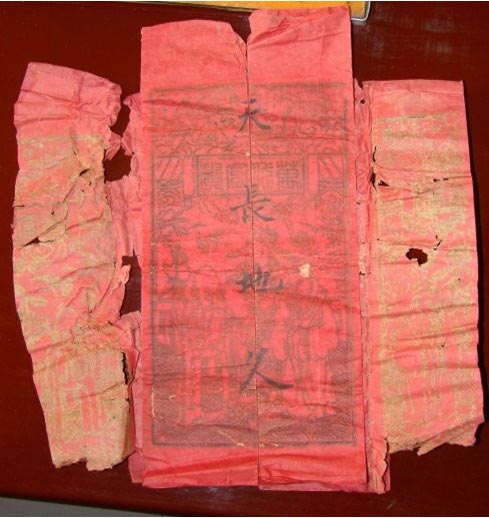

 |
The written marriage proposal, which can trace its origin to 150 years ago and is still well kept in Baokang County Archives, is vital to reveal us the marriage custom prevailing then.
Made by woodblock print in red color, the written marriage proposal still remains in good condition. According to textual research, it was made around the 1860s or 1870s, namely about 150 years ago. Even now, it still boasts legible pictures and fresh scarlet color.
The written marriage proposal is formed like folding folio, after folded; it measures 20 centimeters in length and 10 centimeters in width, and features a blessing picture with the marital wish of “eternality” inscribed on the edges of folded sheet. The blissful dragon and phoenix patterns are highlighted above the horizontal scroll writing “everlasting prosper and honor for generations”. Unfolded, the couple’s birth information will be indicated against the background of "囍" character (meaning marriage in Chinese) inside the folio, the left of the unfolded sheet indicates “bride’s birth: Chou Period (1 am - 3 am), April 22, the fifty-third year C5 of the 60 year cycle” and the right side indicates “bridegroom’s birth: Chou Period (1 am - 3 am), August 16, the fifty-third year C5 of the 60 year cycle”. As a rule, the written marriage proposal would be included inside a red envelope.
Under the domination of feudal ethics and superstitious regime, marriage in feudal society was not the free-will choice of the involved couple, but a decision made by their parents with the coordinating assistance of matchmaker. A series of unwritten tacit conventions were commonly followed for the proposal to the conclusion of marriage, which led to the formation of unique custom in northwest of Hubei Province. No doubt, the circulation of written marriage proposal under due rules is the most significant component of such unique custom.
Back then, marriage proposal would start with such indispensible routine as household visits and exchange of detailed birth information of the couple under consideration. Normally speaking, matchmaker would assume important role in bridging together two financially and socially well matched families. After mutual consent arrived by the two families, the to-be-bride’s family would call on the to-be-bridegroom’s household, probably for multiple times, to gain thorough understanding. Upon being satisfactory with the result of the household visits, the to-be-bride’s family would hand in the girl’s birth information (stated the hour, day, month and year of her birth) to the fortune-teller, who would write down such information on red paper and put it into red envelop. Then, in the so-called “horoscope dispatching” step, the girl’s specific birth information (namely the eight characters of a horoscope) would be delivered by matchmaker together with the red envelop to the to-be-bridegroom’s household. After the step, it was the to-be-bridegroom’s family that had the final saying for the marriage. The to-be-bridegroom’s family would put the red envelop under the family’s ancestor shrine for three or seven days, during which, anything with bad omens like breaking bowl, falling oil kettle, sickening livestock, family quarrel was not expected to happen. If no such unfortunate thing ever occurred during the testing duration, and if more luckily, something with auspicious signs did take place (like unexpected windfall), the to-be-bride would be deemed as an auspicious choice for the family. However, if the couple’s fates were believed to be offensive against each other as revealed by occurring accidents with bad omens, the red envelope would be returned to the to-be-bride’s family. After the girl was deemed as promising choice by the to-be-bridegroom’s family, the latter would hand in birth information of the couple to fortune-teller for further judgment, to discern whether the fates of the couple repel from and offend against each other in light of the rules on generation-inhibition in five elements, and to analyze whether the couple under consideration was good match from the angles of fate combination, fate similarity, birth year, yin-yang principle, etc. If the couple’s eight characters of horoscope were proved well matched, the two were believed ideal for marriage. In the written marriage proposal, the to-be-bride and to-be-bridegroom’s birth information were believed carrying hidden information about their destiny.
After the eight characters of horoscope of the involved couple were attested to be good match, the man’s family would have right to visit the girl’s household. If satisfied, the to-be-bridegroom side will send the man’s birth information to the girl’s family, indicating the satisfaction of the man’s family towards the girl and the readiness for marriage. The written marriage proposal kept by the archives is the one send back to the to-be-bride family by the to-be-bridegroom family. Together with the returned written marriage proposal, betrothal gifts and certain amount of silvers would be delivered by the matchmaker to the to-be-bride family as well. In return, hat, shoes together with wallet would be brought back to the to-be-bridegroom by the matchmaker on behalf of the to-be-bride family as gifts in exchange.
Upon such gift exchange, the families of both sides would be deemed as relatives by marriage. One meeting would be scheduled between fathers of the girl and the man. On the scheduled date, the father of the girl, as accompanied by the matchmaker, would call on the man’s family with gifts like wine, meat and cakes to consult on the proper day for marriage ceremony. Likened to marriage certificate of nowadays, written marriage proposal is one of significant credentials bearing evidence to the marriage in feudal society. Yet, along with the progress of society and reformed marriage system, the traditional written marriage proposal has long been vanished in history.
 |
 Attendants-to-be join Mr. & Miss Campus Contest
Attendants-to-be join Mr. & Miss Campus Contest China hosts overseas disaster relief exercise for the first time
China hosts overseas disaster relief exercise for the first time 20 pairs of twins who will become flight attendants in Sichuan
20 pairs of twins who will become flight attendants in Sichuan J-11 fighters in air exercise
J-11 fighters in air exercise PLA soldiers operating vehicle-mounted guns in drill
PLA soldiers operating vehicle-mounted guns in drill Beauties dancing on the rings
Beauties dancing on the rings Blind carpenter in E China's Jiangxi
Blind carpenter in E China's Jiangxi Top 10 highest-paid sports teams in the world
Top 10 highest-paid sports teams in the world In photos: China's WZ-10 armed helicopters
In photos: China's WZ-10 armed helicopters Obama is sowing discontent in S.China Sea
Obama is sowing discontent in S.China Sea Rescuers work through night to reach cruise ship survivors
Rescuers work through night to reach cruise ship survivors Driving through limbo
Driving through limbo Facing down MERS
Facing down MERSDay|Week